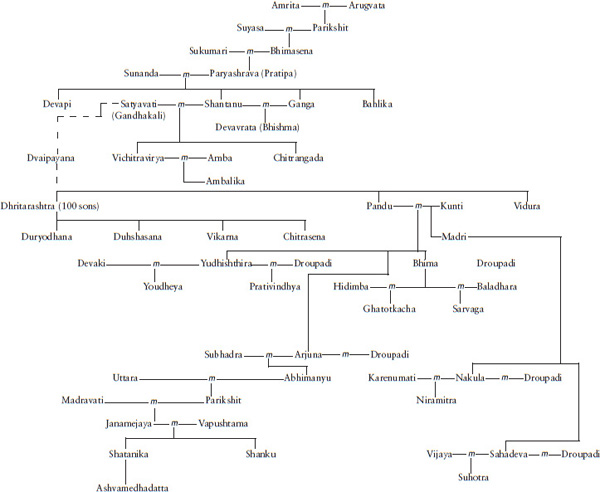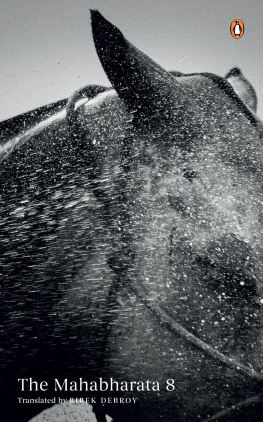B ibek Debroy is a member of NITI Aayog, the successor to the Planning Commission. He is an economist who has published popular articles, papers and books on economics. Before NITI Aayog, he has worked in academic institutes, industry chambers and for the government. Bibek Debroy also writes on Indology and Sanskrit. Penguin published his translation of the Bhagavad Gita in 2006 and Sarama and Her Children: The Dog in Indian Myth in 2008. The 10-volume unabridged translation of the Mahabharata was sequentially published between 2010 and 2014 and he is now translating the Hari Vamsha, to be published in 2016. Bibek Debroy was awarded the Padma Shri in 2015.
Praise for the Series
The modernization of language is visible, its easier on the mind, through expressions that are somewhat familiar. The detailing of the story is intact, the varying tempo maintained, with no deviations from the original. The short introduction reflects a brilliant mind. For those who passionately love the Mahabharata and want to explore it to its depths, Debroys translation offers great promise...
Hindustan Times
[Debroy] has really carved out a niche for himself in crafting and presenting a translation of the Mahabharata... The book takes us on a great journey with admirable ease.
Indian Express
The first thing that appeals to one is the simplicity with which Debroy has been able to express himself and infuse the right kind of meanings... Considering that Sanskrit is not the simplest of languages to translate a text from, Debroy exhibits his deep understanding and appreciation of the medium.
The Hindu
Overwhelmingly impressive... Bibek is a truly eclectic scholar.
Business Line
Debroys lucid and nuanced retelling of the original makes the masterpiece even more enjoyably accessible.
Open
The quality of translation is excellent. The lucid language makes it a pleasure to read the various stories, digressions and parables.
Tribune
Extremely well-organized, and has a substantial and helpful Introduction, plot summaries and notes... beautiful example of a well thought-out layout which makes for much easier reading.
Book Review
The dispassionate vision [Debroy] brings to this endeavour will surely earn him merit in the three worlds.
Mail Today
Thoroughly enjoyable and impressively scholarly...
DNA
Debroys is not the only English translation available in the market, but where he scores and others fail is that his is the closest rendering of the original text in modern English without unduly complicating the readers understanding of the epic.
Business Standard
The brilliance of Ved Vysya comes through.
Hindustan Times
For my wife, Suparna Banerjee (Debroy), who has walked this path of dharma with me
Ardha bhry manuyasya bhry rehatama sakh
Bhry mulam trivargasya bhry mitram mariyata
Mahabharata (1/68/40)
Nsti bhrysamo bandhurnsti bhryasam gati
Nsti bhryasamo loke sahyo dharmasdhana
Mahabharata (12/142/10)
Family Tree
Bharata/Puru Lineage



Map of Bharatavarsha
Bharatavarsha (sixth century BCE)

Introduction
T he Hindu tradition has an amazingly large corpus of religious texts, spanning Vedas, Vedanta (brahmanas, smritis, Puranas, dharmashastras and itihasa. For most of these texts, especially if one excludes classical Sanskrit literature, we dont quite know when they were composed and by whom, not that one is looking for single authors. Some of the minor Puranas (Upa Purana) are of later vintage. For instance, the Bhavishya Purana (which is often listed as a major Purana or Maha Purana) mentions Queen Victoria.
In the listing of the corpus above figures itihasa, translated into English as history. History doesnt entirely capture the nuance of itihasa, which is better translated as this is indeed what happened. Itihasa isnt myth or fiction. It is a chronicle of what happened; it is fact. Or so runs the belief. And itihasa consists of Indias two major epics, the Ramayana and the Mahabharata. The former is believed to have been composed as poetry and the latter as prose. This isnt quite correct. The Ramayana has segments in prose and the Mahabharata has segments in poetry. Itihasa doesnt quite belong to the category of religious texts in a way that the Vedas and Vedanta are religious. However, the dividing line between what is religious and what is not is fuzzy. After all, itihasa is also about attaining the objectives of dharma, and the Mahabharata includes Hinduisms most important spiritual textthe Bhagavad Gita.
The epics are not part of the shruti tradition. That tradition is like revelation, without any composer. The epics are part of the smriti tradition. At the time they were composed, there was no question of texts being written down. They were recited, heard, memorized and passed down through the generations. But the smriti tradition had composers. The Ramayana was composed by Valmiki, regarded as the first poet or kavi. The word kavi has a secondary meaning as poet or rhymer. The primary meaning of kavi is someone who is wise.
And in that sense, the composer of the Mahabharata was no less wise. This was Vedavyasa or Vyasadeva. He was so named because he classified (vyasa) the Vedas. Vedavyasa or Vyasadeva isnt a proper name. It is a title. Once in a while, in accordance with the needs of the era, the Vedas need to be classified. Each such person obtains the title and there have been twenty-eight Vyasadevas so far.
At one level, the question about who composed the Mahabharata is pointless. According to popular belief and according to what the Mahabharata itself states, it was composed by Krishna Dvaipayana Vedavyasa (Vyasadeva). But the text was not composed and cast in stone at a single point in time. Multiple authors kept adding layers and embellishing it. Sections just kept getting added and it is no ones suggestion that Krishna Dvaipayana Vedavyasa composed the text of the Mahabharata as it stands today.
Consequently, the Mahabharata is far more unstructured than the Ramayana. The major sections of the Ramayana are known as




















